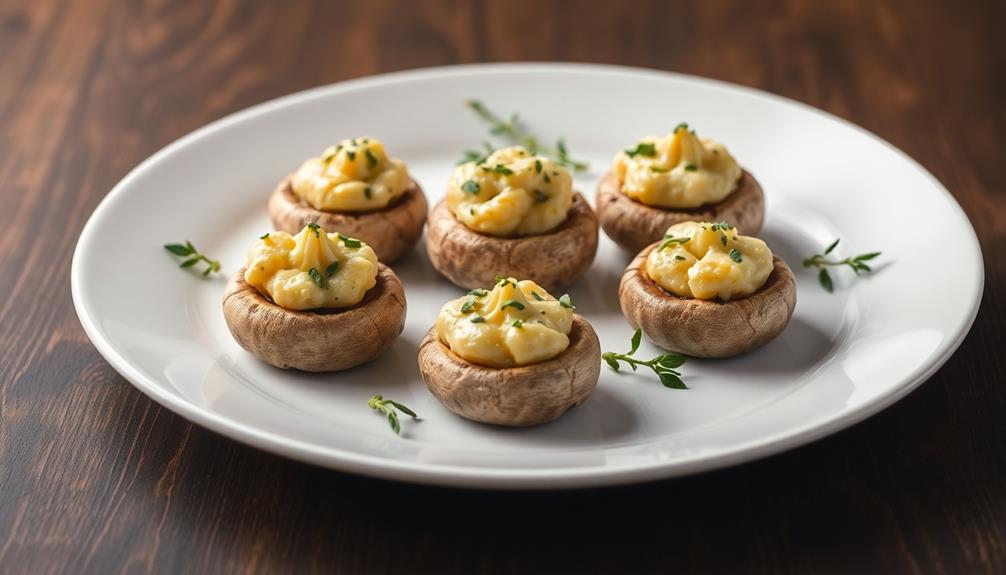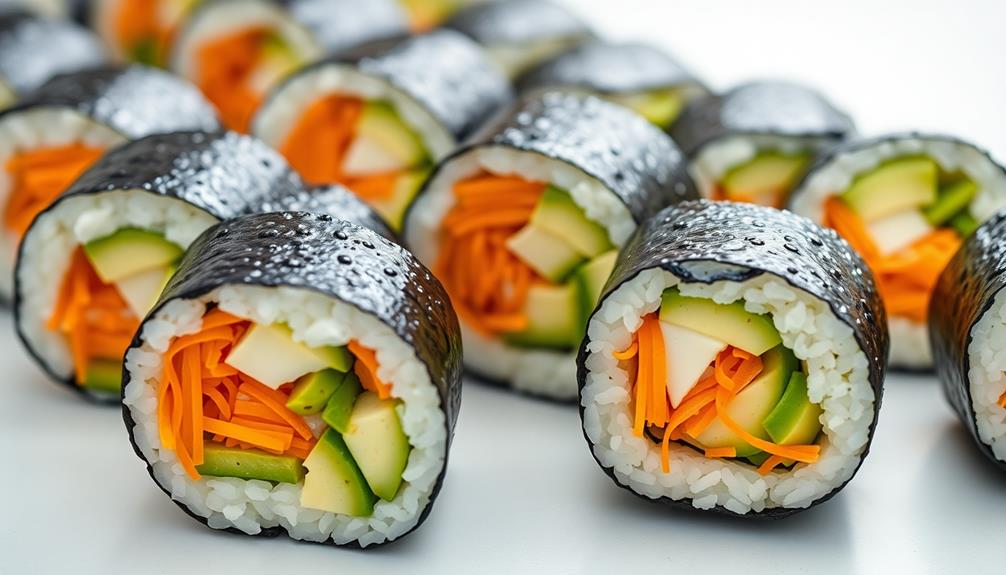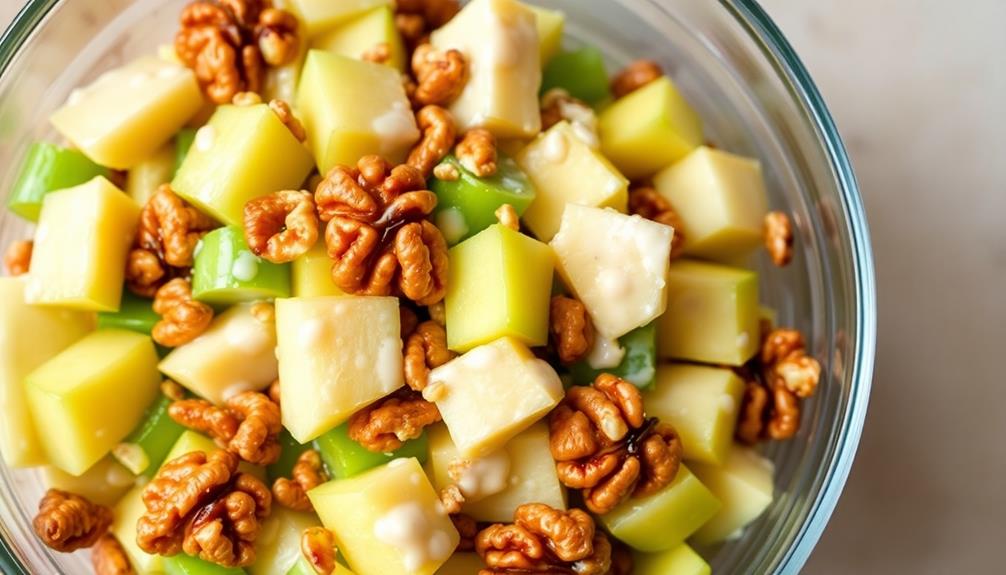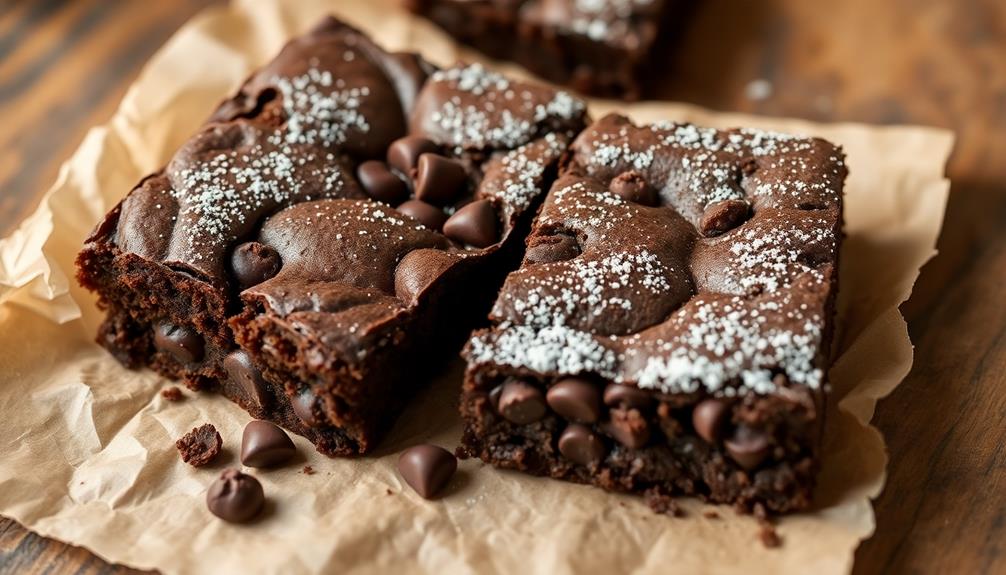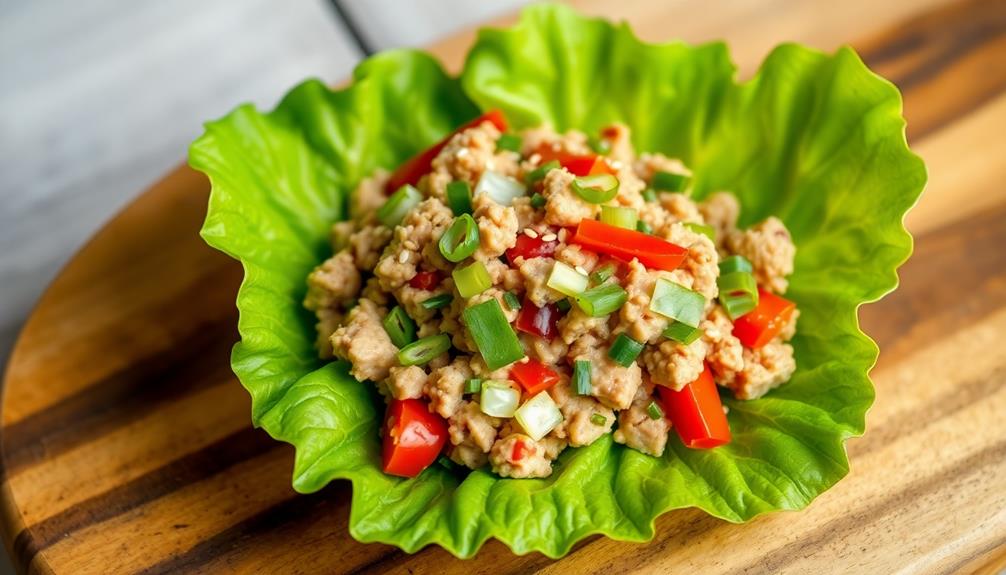Spring rolls are a beloved appetizer enjoyed across Asia, featuring a delightful blend of fresh vegetables, savory proteins, and a satisfying crunch in every bite. Originating in China centuries ago, these crispy treats have evolved into regional specialties, with fillings like pork and shrimp in Vietnam or glass noodles in Thailand. Making spring rolls at home allows you to customize the flavors, from classic combinations to adventurous new twists. The simple rolling technique creates an impressive presentation, and serving them with flavorful dipping sauces takes the experience to new heights. Dive deeper into the world of spring rolls to discover their rich history and endless culinary possibilities.
Key Takeaways
- Spring rolls originated in China during the Spring and Autumn period and have evolved to include diverse fillings across different Asian cuisines.
- Spring rolls are popular appetizers or snacks that offer a blend of textures and flavors, enhancing the dining experience.
- Making spring rolls allows for experimentation with various fillings, such as vegetables, meats, and seafood, as well as customization to suit different preferences.
- The cooking process for spring rolls typically involves soaking rice paper wrappers, filling them with fresh ingredients, and then frying or baking them until golden brown.
- Homemade spring rolls can impress guests and family, showcasing culinary skills and creativity, and can be made in batches for parties or gatherings.
History
Originating in China, spring rolls have a rich and storied past, with their origins dating back to the Spring and Autumn period (771-476 BC). During this time, people began wrapping seasonal vegetables in thin sheets of dough, creating a portable and nourishing snack.
Over the centuries, the recipe evolved, with the addition of meat and seafood fillings, as well as the distinctive crispy exterior that we know and love today.
As spring rolls spread across Asia, they took on unique regional flavors. In Vietnam, they're often filled with pork, shrimp, and vegetables, while in Thailand, you might find them stuffed with glass noodles and a piquant chili sauce.
No matter where you go, spring rolls are a beloved delicacy that capture the essence of the season. Whether you're enjoying them as an appetizer or a light meal, they're sure to delight your taste buds and transport you to faraway lands.
Recipe
Spring rolls are a beloved appetizer or snack that can be found in many Asian cuisines. These delightful rolls are made by wrapping a variety of fresh ingredients in a thin, crispy wrapper. The result is a harmonious blend of textures and flavors that's sure to delight the senses.
The process of making spring rolls can be a fun and rewarding experience, allowing you to experiment with different fillings and discover your own personal preferences. Whether you prefer a more traditional approach or a creative twist, the joy of crafting these rolls from scratch is well worth the effort.
Ingredients:
- 8 ounces rice paper wrappers
- 2 cups shredded cabbage
- 1 cup shredded carrots
- 1 cup bean sprouts
- 1/2 cup sliced green onions
- 1/2 cup chopped fresh mint leaves
- 1/2 cup chopped fresh cilantro
- 2 tablespoons soy sauce
- 1 tablespoon rice vinegar
- 1 teaspoon sesame oil
- 1/2 teaspoon ground ginger
Cooking Instructions:
Soak the rice paper wrappers in warm water for 30 seconds to 1 minute, or until they become pliable. Lay the wrappers on a clean, flat surface.
In a bowl, combine the cabbage, carrots, bean sprouts, green onions, mint, and cilantro. In a separate bowl, mix the soy sauce, rice vinegar, sesame oil, and ground ginger. Add the sauce to the vegetable mixture and stir to combine.
Spoon a portion of the filling onto the bottom third of each wrapper, then fold the sides inward and roll tightly to enclose the filling. Serve the spring rolls immediately, or store them in an airtight container in the refrigerator until ready to serve.
Tips:
Ensure that the rice paper wrappers aren't overly soaked, as they can become difficult to work with. Adjust the filling ingredients to your personal taste preferences, and consider adding cooked shrimp, chicken, or tofu for added protein.
Serve the spring rolls with a dipping sauce, such as a sweet chili sauce or a peanut sauce, for a complete and satisfying snack or appetizer.
Cooking Steps
Alright, let's get started on those spring rolls!
First, you'll want to wet your rice paper wrapper and get it nice and pliable.
Next, add your favorite filling ingredients – just be sure to place them in the center and leave some space at the edges.
Now, tightly roll up that wrapper, making sure to seal it well so your rolls stay together.
Time to serve 'em up with a delicious dipping sauce!
Step 1. Wet Rice Paper Wrapper

Typically, you'll want to wet the rice paper wrapper briefly under warm water before assembling your spring rolls. This softens the wrapper and makes it pliable, allowing you to roll and shape your spring rolls with ease.
Dip the entire wrapper in the water, letting it soak for just a few seconds. Be careful not to oversaturate it, as that can make the wrapper too fragile and difficult to work with.
Once the wrapper is wet, gently shake off any excess water and lay it flat on a clean, dry surface. The wrapper may feel a bit sticky, but that's normal.
Now you can start building your spring roll, placing your fillings in the center and rolling it up tightly. The damp wrapper will stick to itself, helping to hold the roll together.
With a little practice, you'll be rolling up delicious spring rolls in no time!
Step 2. Add Filling Ingredients
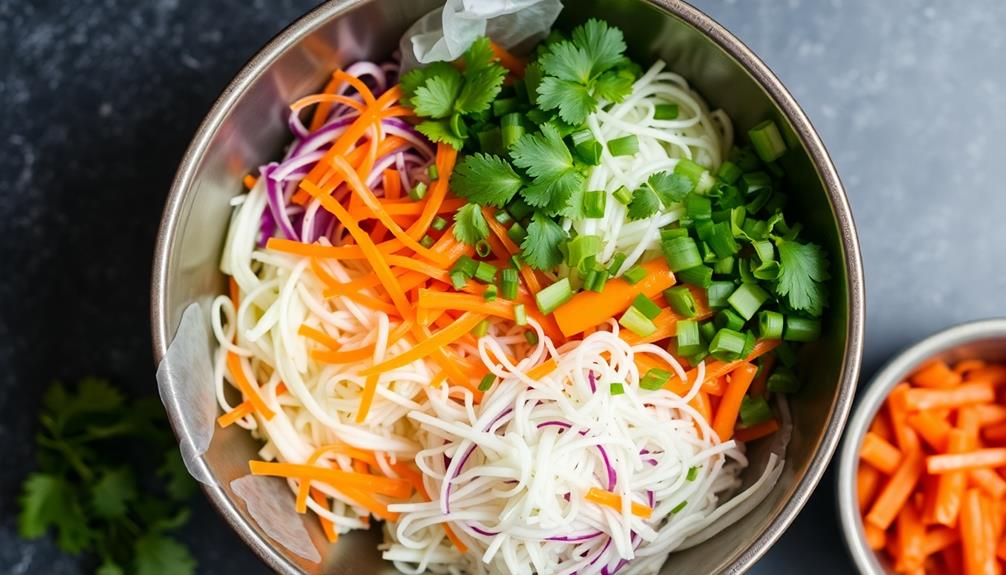
Once you have your softened rice paper wrapper ready, it's time to start building your spring roll.
First, you'll want to add a few crisp, fresh veggies. Julienne some carrots and cucumbers, or thinly slice up some lettuce and cabbage. These crunchy, colorful ingredients will give your spring roll a satisfying texture.
Next, you can add a protein like cooked shrimp, sliced chicken, or tofu. Arrange the fillings in the center of the wrapper, leaving a couple of inches on each side. Be sure not to overstuff, as this can make the wrapper tear.
Now it's time to roll it up! Fold the bottom of the wrapper over the filling, then fold in the sides and continue rolling tightly up to the top. If the wrapper is not sealing well, dip your fingers in water and run them along the edge to help it stick. Once the roll is complete, place it seam-side down on a plate. If you’re interested in learning about different types of spring rolls, be sure to explore and learn about diploma rollups. These delicious treats come in a variety of flavors and fillings, making them a versatile and popular choice for appetizers or snacks.
With the filling nicely tucked inside, your spring roll is ready to enjoy. Feel free to get creative with different flavor combinations – the possibilities are endless!
Step 3. Tightly Roll the Wrapped Filling

After arranging the fillings in the center of the wrapper, tightly roll the spring roll. Grip the bottom corner of the wrapper and fold it over the filling.
Then, fold the sides inward and continue to roll the wrapper up tightly, using your fingers to keep the filling secure as you go. Roll it into a tight, neat cylinder.
Be gentle yet firm, making sure not to tear the delicate wrapper. As you roll, the wrapper will stick to itself, sealing the spring roll.
Keep rolling until you reach the top corner of the wrapper. Gently press down to seal the roll.
Repeat this process for each spring roll, creating a batch of beautifully rolled treats. The tightly wrapped filling will ensure your spring rolls hold their shape and stay fresh.
Now you're ready to fry or bake your homemade spring rolls to golden perfection!
Step 4. Tightly Seal the Rolled Wrapper

To seal the rolled wrapper, firmly press down on the seam to ensure it adheres. Run your fingers along the entire length, gently pressing to create a tight seal. This will prevent the filling from spilling out as you fry the spring rolls.
Next, use your palms to roll the wrapper tightly, starting from one end and working your way to the other. Apply even pressure to maintain a uniform shape. Be careful not to tear the delicate wrapper. As you roll, the wrapper should conform neatly around the filling, creating a compact and cohesive spring roll.
Once fully rolled, moisten the final edge with a bit of water to help it stick. Pinch and hold the seam closed for a few seconds, sealing the wrapper completely. This will lock in the filling and prevent unraveling during the cooking process.
With the wrapper securely sealed, your spring rolls are now ready for frying!
Step 5. Serve Immediately With Dipping Sauce

Carefully lower the sealed spring rolls into the hot oil and fry them until golden brown, about 2-3 minutes per batch.
Be sure to fry them in small batches to maintain the oil's temperature. Once they're nicely browned, remove the spring rolls from the oil and place them on a paper towel-lined plate to drain off any excess oil.
Serve the crispy spring rolls immediately while they're hot and crunchy. They'll be simply irresistible!
Offer a tasty dipping sauce on the side. A sweet and tangy sauce, like a Thai-style chili sauce or a soy-based dipping sauce, is a classic pairing.
The contrast of the warm, crispy rolls and the cool, flavorful dip is truly delightful. Encourage your guests to dunk the spring rolls in the sauce and enjoy every bite.
These freshly fried spring rolls are sure to be the star of your meal or appetizer spread.
Final Thoughts
Ultimately, spring rolls make a delightful appetizer or snack that can be customized to suit your taste preferences.
Whether you prefer a classic filling or something more adventurous, the possibilities are endless. The beauty of spring rolls lies in their versatility – you can experiment with different ingredients and flavors to create your own unique masterpiece.
As you've seen, the process of making spring rolls is relatively straightforward, and the result is a tasty treat that's sure to impress your friends and family.
Don't be afraid to get creative and put your own spin on this timeless dish. With a little practice, you'll be rolling like a pro in no time.
Frequently Asked Questions
What's the Difference Between Spring Rolls and Egg Rolls?
You'll find that spring rolls and egg rolls differ in their fillings and cooking methods. Spring rolls typically have a lighter, more veggie-based filling, while egg rolls usually contain more meat and are fried rather than baked.
Can I Use Frozen Spring Roll Wrappers?
You can absolutely use frozen spring roll wrappers! They're a convenient option that'll save you time. Just be sure to follow the package instructions for proper preparation and cooking. Enjoy your homemade spring rolls with the frozen wrappers!
How Long Can I Store Cooked Spring Rolls?
You can store cooked spring rolls in the refrigerator for up to 3-4 days. Make sure to let them cool completely before storing in an airtight container. Reheat in the oven or air fryer when ready to enjoy.
What's the Best Dipping Sauce for Spring Rolls?
The best dipping sauce for your spring rolls really depends on your personal taste preferences. You could try a tangy soy sauce, a sweet chili sauce, or a creamy peanut sauce – experiment to find your favorite!
Can I Bake Spring Rolls Instead of Frying?
You can certainly bake spring rolls instead of frying them. The result won't be as crispy, but it's a healthier option that can still deliver delicious flavors. Give it a try and see what you think!
Conclusion
Spring rolls are a delightful treat that'll transport you on a flavor journey! You'll love the crispy, golden shell and the tasty, fresh filling. They're perfect for sharing with friends or enjoying as a snack. Once you've tried making them, you'll be hooked! So, get rolling and savor the deliciousness. This is a recipe you'll want to make again and again.

